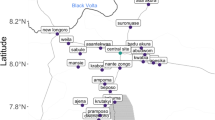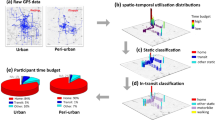Abstract
Most air pollution and health studies conducted in recent years have examined how a health outcome is related to pollution concentrations from a fixed outdoor monitor. The pollutant effect estimate in the health model used indicates how ambient pollution concentrations are associated with the health outcome, but not how actual exposure to ambient pollution is related to health. In this article, we propose a method of estimating personal exposures to ambient PM2.5 (particulate matter less than 2.5 μm in diameter) using sulfate, a component of PM2.5 that is derived primarily from ambient sources. We demonstrate how to use regression calibration in conjunction with these derived values to estimate the effects of personal ambient PM2.5 exposure on a continuous health outcome, forced expiratory volume in 1 s (FEV1), using repeated measures data. Through simulation, we show that a confidence interval (CI) for the calibrated estimator based on large sample theory methods has an appropriate coverage rate. In an application using data from our health study involving children with moderate to severe asthma, we found that a 10 μg/m3 increase in PM2.5 was associated with a 2.2% decrease in FEV1 at a 1-day lag of the pollutant (95% CI: 0.0–4.3% decrease). Regressing FEV1 directly on ambient PM2.5 concentrations from a fixed monitor yielded a much weaker estimate of 1.0% (95% CI: 0.0–2.0% decrease). Relatively small amounts of personal monitor data were needed to calibrate the estimate based on fixed outdoor concentrations.
This is a preview of subscription content, access via your institution
Access options
Subscribe to this journal
Receive 6 print issues and online access
$259.00 per year
only $43.17 per issue
Buy this article
- Purchase on Springer Link
- Instant access to full article PDF
Prices may be subject to local taxes which are calculated during checkout


Similar content being viewed by others
Abbreviations
- CI:
-
confidence interval
- ETS:
-
environmental tobacco smoke
- FEV1:
-
forced expiratory volume in 1 second
- F INF :
-
indoor concentration of a pollutant divided by the ambient level of that pollutant
- MSE:
-
mean-squared error
- PM2.5:
-
particulate matter less than 2.5 μm in diameter
- F PEX :
-
personal pollutant exposure concentration divided by the ambient level of that pollutant
- RTI:
-
Research Triangle Institute
- REML:
-
restricted maximum likelihood
- SD:
-
standard deviation
- SE:
-
standard error.
References
Agresti A. Categorical Data Analysis, 2nd edn. John Wiley & Sons, New Jersey, 2002.
Carroll R.J., Ruppert D., and Stephanski L.A. Measurement Error in Nonlinear Models. Chapman and Hall, London, 1995.
Ebelt S.T., Petkau A.J., Vedal S., Fisher T.V., and Brauer M. Exposure of chronic obstructive pulmonary disease patients to particulate matter: relationships between personal and ambient concentrations. J Air Waste Manage Assoc 2000: 50: 1081–1094.
Fuller W.A. Measurement Error Models. John Wiley & Sons, New York, 1987.
Haukka J.K. Correction for covariate measurement error in generalized linear models — a bootstrap approach. Biometrics 1995: 51: 1127–1132.
Janssen N.A.H., Hoek G., Brunekreef B., Harssema H., Mensink I., and Zuidhof A. Personal sampling of particles in adults: relation among personal, indoor, and outdoor air concentrations. Am J Epidemiol 1998: 146: 537–547.
Janssen N.A.H., Hoek G., Harssema H., and Brunekreef B. Childhood exposure to PM10: relation between personal, classroom, and outdoor concentrations. Occup Environ Med 1997: 54: 888–894.
Janssen N.A.H., Hoek G., Harssema H., and Brunekreef B. Personal exposure to fine particles in children correlates closely with ambient fine particles. Arch Environ Health 1999: 54: 95–101.
Lawless P.A. Portable air sampling apparatus including non-intrusive activity monitor and methods of using same, US Patent 6,502,469 B2, awarded 1/7/2003, Research Triangle Institute, Research Triangle Park, NC 27709.
Lawless P.A., Rodes C.E., and Ensor D.S. Multiwavelength absorbance of filter deposits for determination of environmental tobacco smoke and black carbon. Atmos Environ 2004: 38: 3373–3383.
Liu L.-J.S., Box M., Kalman D., Kaufman J., Koenig J., Larson T., Lumley T., Sheppard L., and Wallace L. Exposure assessment of particulate matter for susceptible populations in Seattle, WA. Environ Health Perspect 2003: 111: 909–918.
Ozkaynak H., Xue J., Spengler J., Wallace L., Pellizzari E., and Jenkins P. Personal exposure to airborne particles and metals: results from the Particle TEAM Study in Riverside, CA. J Exposure Anal Environ Epidemiol 1996: 6: 57–78.
Rabinovitch N., Zhang L., Murphy J., Vedal S., Dutton S.J., and Gelfand E.W. Health effects of wintertime ambient air pollution on children with moderate to severe asthma. J Allergy Clin Immunol 2004: 114: 1131–1137.
Richardson A.M., and Welsh A.H. Asymptotic properties of restricted maximum likelihood (REML) estimates for hierarchical mixed models. Aust J Stat 1994: 36: 31–43.
Rodes C.E., Lawless P.A., Evans G.F., Sheldon L.S., Williams R.W., Vette A.F., Creason J.P., and Walsh D. The relationships between personal PM exposures for elderly populations and indoor and outdoor concentrations for three retirement center scenarios. J Exposure Anal Environ Epidemiol 2001: 11: 103–115.
Rojas-Bracho L., Suh H.H., and Koutrakis P. Relationship among personal, indoor, and out-door particle concentrations for individuals with COPD. J Exposure Anal Environ Epidemiol 2000: 10: 294–306.
Rosner B., Willett W.C., and Spiegelman D. Correction of logistic regression relative risk estimates and confidence intervals for systematic within-person measurement error. Stat Med 1989: 8: 1051–1069.
Sarnat J.A., Long C.M., Koutrakis P., Coull B.A., Schwartz J., and Suh H.H. Using sulfur as a tracer of outdoor fine particulate matter. Environ Sci Technol 2002: 36: 5305–5314.
Williams R., Suggs J., Zweidinger R., Evans G., Creason J., Kwok R., Rodes C., Lawless P., and Sheldon L. The 1998 Baltimore Particulate Epidemiology — Exposure Study: Part 1. Comparison of ambient, residential outdoor, indoor and apartment particulate matter monitoring. J Exposure Anal Environ Epidemiol 2000: 10: 518–532.
Wilson W., Mage D., and Grant L. Estimating separately personal exposure to ambient and nonambient particulate matter for epidemiology and risk assessment: why and how. J Air Waste Manage Assoc 2000: 50: 1167–1183.
Wilson W., and Suh H. Fine particles and coarse particles: concentration relationships relevant to epidemiologic studies. J Air Waste Manage Assoc 1997: 47: 1238–1249.
Zeger S., Thomas D., Dominici F., Samet J.M., Schwartz J., Dockery D., and Cohen A. Exposure measurement error in time-series studies of air pollution: concepts and consequences. Environ Health Perspect 2000: 108: 419–426.
Acknowledgements
This work was funded in part by three grants: EPA R825702, Thrasher Research Fund 02816-8 and, Colorado Tobacco Research Program R2-001.
Author information
Authors and Affiliations
Corresponding author
Appendix A
Appendix A
Estimating the Ratio of PM2.5 to Sulfate Exposure Factors (λ)
A general approach to estimating λ
(i) Perform a mixed model regression of total personal PM2.5 on ambient PM2.5, where fixed and subject-specific random terms for both the y-intercept and slope of ambient PM2.5 are included in the model. If nonambient and ambient PM2.5 exposures are approximately independent of each other, which our data suggested (also see Wilson and Suh, 1997), then the personal slope (fixed slope plus subject-specific random slope) indicates the average fraction of ambient PM2.5 that the subject is exposed to within the study period, while the y-intercept indicates average exposure to nonambient sources. (ii) Repeat the previous step, with personal sulfate and ambient sulfate. (iii) The estimate of λ for a given subject is then obtained by dividing the personal PM2.5 slope by the personal sulfate slope. (iv) The common λ can be obtained by averaging subject-specific estimates.
Notes on Calculations
Data for the 21 “low-ETS” children were used to estimate subject-specific λ values. (A “low-ETS” subject was defined as one who (i) claimed to not live in a home with a smoker, and (ii) infrequently had days with high measured personal ETS exposure within the study period.) The average estimated value across subjects (λ̂=(1/n)∑iλ̂i) was 0.78 (median=0.75, SD=0.285, min=0.44, max=1.59). The regression of total personal PM2.5 on ambient PM2.5 for the remaining 29 subjects produced counterintuitive results; the slope estimate for the group was near zero, with no strong outliers apparent in the data. But slope estimates were similar between ETS groups for the sulfate regressions (and confirmed when analyzing another strong ambient-sourced PM2.5 component, elemental carbon). This reaffirmed our belief that exposures to ambient PM2.5 were probably more similar between ETS groups and that more complex statistical methods were necessary to model accurately those not in the low-ETS group.
Details for Simulations
Based on observed fits, we assumed ωit′∼N(0,10) (i.e., ωit′ has a normal distribution with mean=0, variance=10), uit∼N(0,2), ωit∼N(0,8), ɛit∼N(0,0.14) and φi∼N(0, 0.014) for all i and t, and that the correlation between FEV1 responses within an individual on two consecutive days was 0.44. For the models below, values for the random terms were sampled independently from these distributions for all i and t, except for ɛit, which were autocorrelated within subjects (AR(1) model) with ρ=0.44. The variance of u was estimated by examining differences in estimated exposures between subjects within days since we did not have true ambient exposures for subjects. The variance for ωit was then determined using σω2=σω′2−σu2. Within each simulation, the following steps were taken.
The Health Model
(i) Ambient exposures were simulated as XitA=0.46Zt+φiZt+ωit. (ii) FEV1 outcomes were then simulated as Yit=2–0.00435XitA+ɛit. (iii) Some FEV1 outcomes were randomly set to missing values so that the pattern and amount of responses were similar to actual data. (Subjects missed having FEV1 values on certain days due to absence or because the recorded FEV1 values were flagged as invalid.) (iv) The generated FEV1 data were then fit as a simple linear function of actual ambient PM2.5 concentrations (with correlated errors) to obtain a simulated estimate of β1.
The Personal Exposure Model
(i) Ambient exposures were simulated (independently of those for the health model) using XitA=0.46Zt+φiZt+ωit for the same subjects and days that personal monitor information was available in the actual study. (ii) Exposures with measurement error were then created as XitA*=XitA+uit. (iii) The generated ambient PM2.5 exposures and actual ambient PM2.5 concentrations were then used to fit model (7), yielding a simulated estimate of θ1.
Rights and permissions
About this article
Cite this article
Strand, M., Vedal, S., Rodes, C. et al. Estimating effects of ambient PM2.5 exposure on health using PM2.5 component measurements and regression calibration. J Expo Sci Environ Epidemiol 16, 30–38 (2006). https://doi.org/10.1038/sj.jea.7500434
Received:
Accepted:
Published:
Issue Date:
DOI: https://doi.org/10.1038/sj.jea.7500434
Keywords
This article is cited by
-
Health effects of concurrent ambient and tobacco smoke-derived particle exposures at low concentrations in children with asthma
Journal of Exposure Science & Environmental Epidemiology (2020)
-
Exposure measurement error in PM2.5 health effects studies: A pooled analysis of eight personal exposure validation studies
Environmental Health (2014)
-
Influence of human activity patterns, particle composition, and residential air exchange rates on modeled distributions of PM2.5 exposure compared with central-site monitoring data
Journal of Exposure Science & Environmental Epidemiology (2013)
-
Examining the representativeness of home outdoor PM2.5, EC, and OC estimates for daily personal exposures in Southern California
Air Quality, Atmosphere & Health (2012)
-
Impact of exposure measurement error in air pollution epidemiology: effect of error type in time-series studies
Environmental Health (2011)



